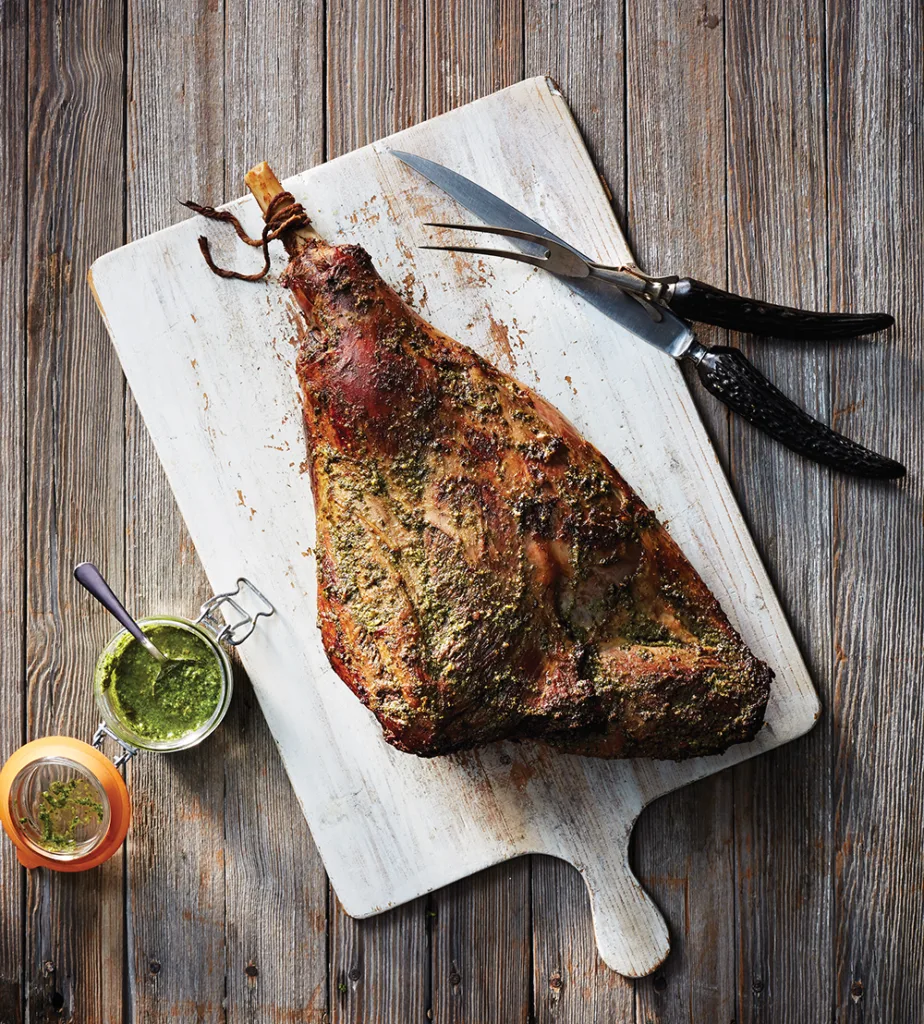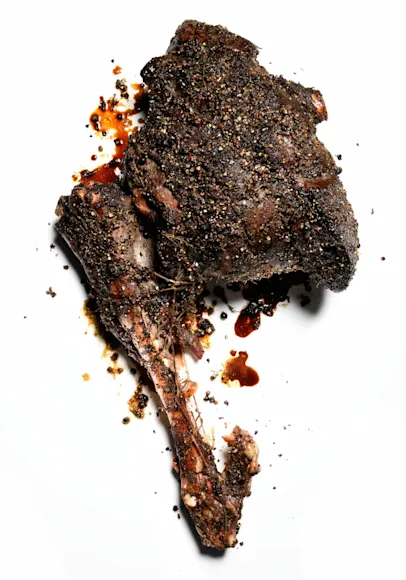Here’s one for your inner caveman: a whole roasted venison
leg, just like Fred Flintstone would’ve cooked it. This is game cookery at its most primal and dramatic, and the results are a showpiece—which is good, as you’ll need a crowd to help you eat it.
How to Roast a Leg of Venison
Because the meat is only mildly doctored—with a classic wet rub of olive oil, thyme, rosemary, garlic, and juniper berries—and cooked in an unforgiving manner, the key to success here is a prime hunk of meat ideally from a younger deer, field dressed impeccably, and aged if possible. Thumping your chest while gnawing the bones is optional.
Make the Rub
In a small bowl, combine the olive oil, thyme, garlic, rosemary, juniper berries, salt, and pepper until it resembles a coarse paste. (Add a little more olive oil, if needed, to make it goopy enough to spread.) Rub this mixture onto the venison, wrap in plastic wrap, and refrigerate overnight. Remove the leg from the refrigerator several hours before cooking. It should be at room temperature when it goes into the oven.
Preheat The Oven
Preheat the oven to 350 degrees. Drizzle the meat with the vegetable oil, patting it lightly with your fingers to coat evenly, and place the leg on the rack of a large roasting pan. Roast, undisturbed, for 1 hour.
Heat the Stock
Heat the stock to a low simmer on the stovetop. Turn the meat. Using a baster or ladle, baste the meat with about half of the hot stock, and roast for another hour.
Turn the Roast
Turn the roast a second time, and repeat the basting. After about 15 minutes, check the meat in its thickest part with an instant-read meat thermometer. The cooking time will depend on the size of the roast. Remove the roast when the thermometer reads 120 degrees for rare, or 126 for medium rare. (The meat will keep cooking after it’s removed.)
Remove the Roast
Remove the roast to a large cutting board and allow it to rest, tented with a few sheets of aluminum foil, for about 20 minutes. Carve and serve.
Ingredients:
1/4 cup olive oil
1/2 cup fresh thyme leaves
8 garlic cloves
minced 1/4 cup rosemary
roughly chopped 3 Tbsp. juniper berries
crushed 1/4 cup kosher salt
1/4 cup cracked black peppercorns
1 whole venison hind leg
bone-in (12-15 lb.)
3 Tbsp. vegetable oil
4 cups game or beef stock

Roast a leg of venison by hanging it from a string and dangle it in the fire. Christopher Testani
Cook a Leg of Venison on a String
I have a hook set beneath my fireplace mantel for the sole purpose of cooking meat this way. The venison is suspended by heavy string from the hook, and the leg spins slowly while it cooks. Every time you walk past, give it a gentle twirl so the venison spins in front of the fire.
Here’s the cool thing about this method: The venison will spin until the string has unwound and then, due to the meat’s weight, it will keep spinning in the opposite direction, and so on. People get a kick out of watching how long the leg will spin without a touch. When you butcher your deer, remove the pelvic bone but keep the leg intact, and scrape down the bone midway so you have a clean, sturdy section of bone on which to tie the string. —Michael Chiarello
Ingredients
1 venison leg (6 to 12 lb.) trimmed of fat and silverskin
3 cups water
2⁄3 cup kosher salt
For the mint pesto:
3 cups fresh mint
1⁄2 cup packed flat-leaf parsley
1 Tbsp. toasted pine nuts1⁄2 tsp.
garlic, minced
1⁄2 cup extra-virgin olive oil
2 Tbsp.
simple syrup
Salt and pepper to taste
Directions
When the venison has been at room temperature for at least 2 hours, start a fire in your fireplace. Allow the fire to burn until the flames have died down and the glowing wood provides a steady, even heat.
Make the saltwater solution: Fill a medium saucepan with the water, add the kosher salt, and bring to a boil over high heat. Turn off the heat and allow the solution to cool. When it’s cool, transfer it to a spray bottle.
Tie a 2-foot-long piece of butcher’s twine securely around the bone at the end of the venison leg. Test it to make sure it will hold the leg’s weight. Tie the other end of the twine to the fireplace hook so the venison is suspended and the bottom of the leg hangs about 8 to 12 inches above the fire. Place a large pan under the venison to catch the drippings.
The leg will begin to spin; give the heel a twist in the direction in which it is turning. Every 10 minutes or so, check to see if the venison is turning. If it’s not, give it a gentle push so it spins.
After about 15 minutes, begin to baste with the saltwater solution every 5 to 10 minutes, spraying the venison leg all the way around.
Feed the fire from both sides (but not from the front), pushing the wood to the center as it burns. As the meat cooks, don’t add any more wood, but let the flames die down so the embers are cooking the venison.
After 90 minutes, begin basting the venison with the mint pesto (recipe below). Set aside half of the pesto as a condiment to serve with the finished venison.
The venison will roast for between 1 and 2 hours for a 6-pound leg and 21⁄2 hours for a 12-pound leg. Check for doneness by inserting an instant-read thermometer in the thickest part of the leg. For medium-rare meat, the temperature should be 130 degrees.
Transfer the venison to a sheet pan, cover lightly with aluminum foil, and let it rest for at least 15 minutes.
Carve the leg. Spoon the carving juices over each slice and top with a generous portion of mint pesto. (If you have leftovers, the venison makes an incredible cold-cut sandwich.)
Mint Pesto
Bring about 2 quarts of water to a boil in a stockpot over high heat. While the water heats, set up an ice bath in a large bowl full of ice and water. When the water is boiling, blanch the mint for about 30 seconds. Use a slotted spoon to transfer the mint to the ice bath.
Blanch the parsley for 30 seconds, then transfer it to the ice bath.
Remove the herbs from the cold water and squeeze them in a ball to remove the excess moisture. Roughly chop them.
In a large, heavy-duty blender or a food processor, blend the herbs, toasted pine nuts, and garlic, pulsing just until combined. With the machine running, drizzle the olive oil in slowly.
Pour in the simple syrup. Salt and pepper to taste.
Adapted from chef Michael Chiarello’s recipe in Wild Gourmet.






